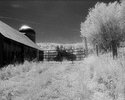Pixophrenic
Member
Browsing my 20+year XP2 negative archive, I could not fail to notice how inconsistent the film processing has been through various labs, when I could not process film at home, and through various home attempts. Now, in addition to that, there are long waiting times and high prices for the relatively scarce C-41 kits. I read with great interest the thread on using BW developing routine of this film. Here, I would like to suggest something different. I am still in the process of testing, but I realized that if some of you enterprising types would like to join in, we would get there faster. Or perhaps I missed other threads where the answer was already provided.
My approach borrows heavily from posts by David Lyga, who advocated using modified RA4 chemistry for C-41 processing. The idea I found attractive is that you first process XP2 using color developer, fix it, but do not remove the silver. The processing sequence would be: develop, stop, fix, wash, rinse in PhotoFlo and dry. This is what became known as “bleach bypass”. Surprisingly, the combined image formed by dyes and silver together looks usable, brownish like the one produced by Pyrocat HD on BW films, especially in those shots done with one stop underexposure. Sure, I will need to demonstrate images to convince you, but at this point I am only wondering if anyone had been down this road already. The specific advantage of this approach is that it offers “bleach bypass” images which can be scanned (sorry if this does not belong here) and then bleach-fixed partially or completely and printed/scanned again for a different effect. The “soul” of this film can thus be revealed through various reducers, not developers
My approach borrows heavily from posts by David Lyga, who advocated using modified RA4 chemistry for C-41 processing. The idea I found attractive is that you first process XP2 using color developer, fix it, but do not remove the silver. The processing sequence would be: develop, stop, fix, wash, rinse in PhotoFlo and dry. This is what became known as “bleach bypass”. Surprisingly, the combined image formed by dyes and silver together looks usable, brownish like the one produced by Pyrocat HD on BW films, especially in those shots done with one stop underexposure. Sure, I will need to demonstrate images to convince you, but at this point I am only wondering if anyone had been down this road already. The specific advantage of this approach is that it offers “bleach bypass” images which can be scanned (sorry if this does not belong here) and then bleach-fixed partially or completely and printed/scanned again for a different effect. The “soul” of this film can thus be revealed through various reducers, not developers
Last edited:





